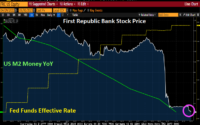Fed Mouthpiece Speaks: “At LEAST 75bps Next Week” Sends Odds Of 100bps Rate Hike to 47%
A little over an hour ago we reported that while everyone was waiting for the Fed’s WSJ mouthpiece Nick Timiraos to leak whatever it is that Powell wanted markets to know during the Fed’s blackout period, Nomura became the first bank to forecast an out of consensus 100bps rate hike during next week’s FOMC meeting.
To some this seemed far too high, but the Nomura case just got a powerful boost moments ago when Timiraos hit publish on his long-awaited WSJ market trial balloon in which he said that “the acceleration in inflation last month clinches the case for the Federal Reserve to lift interest rates by AT LEAST 0.75 percentage point at its meeting next week and raises the prospect of hefty increases continuing in coming months.”
Another large jump in underlying prices squashes hopes for a slower pace of interest-rate increases
The August CPI could lead more officials to project somewhat higher rates relative to previous expectations in next week’s quarterly projections https://t.co/3e4yCcHOMh
— Nick Timiraos (@NickTimiraos) September 13, 2022
He continues:
Fed officials had suggested they were prepared to make their third consecutive increase of 0.75 point next week even if inflation had cooled in August, as many economists were anticipating.
Some officials had begun considering how to slow their pace of rate increases on the expectation that inflation pressures might soon moderate, allowing them to raise rates in more traditional quarter-point increments by December.
But the latest inflation figures make it more difficult for the Fed to reduce its rate rises this fall, and they likely squash any debate around a smaller half-percentage-point rate rise next week.
The mouthpiece goes on that the Fed hasn’t raised rates by a full percentage point at one meeting since it began using the federal-funds rate as its primary tool for setting monetary policy in the early 1990s. Officials opted against the larger one-percentage-point rate rise at their meeting in late July, when they raised rates by 0.75 percentage point.
But this time will likely be different as the contemplates a rate hike of “at least” 75 bps.
Timiraos cited KPMG chief economist Diane Swonk, who said that “This report is a nightmare. This puts a one-percent rate rise definitely on the table.” That said, he also quoted Evercore ISIS economists who said “we see little-to-no chance,” of a 100bps rate hike.
But the final word of course belongs to Powell; and here Timiraos quotes the Fed chair who on July 27 said that “we wouldn’t hesitate to make an even larger move than we did today if the committee were to conclude that that was appropriate.”
Powell sent markets reeling last month with a speech in Jackson Hole, Wyo., that appeared to push back against market expectations of a slowdown in rate rises. He repeated his concern that consumers would begin to anticipate higher prices to persist, creating a self-fulfilling cycle of high inflation.
“The longer the current bout of high inflation continues, the greater the chance that expectations of higher inflation will become entrenched,” he said.
And while a 100bps rate hike now appears to be in the page, the even bigger issue is where the terminal rate will be. As a reminder, Nomura now sees terminal around 4.50%-4.75%. Jefferies chief economist Aneta Markowska agrees: “The messaging from the Fed is likely to shift very quickly from a 4% terminal funds rate toward 4.5% and perhaps even higher.”
Timiraos also quotes from a speech last week by Fed governor Christopher Waller in which he pointed to how a short-term deceleration in inflationary pressures one year ago led the central bank to delay plans to withdraw stimulus. Inflation subsequently accelerated.
“The consequences of being fooled by a temporary softening in inflation could be even greater now if another misjudgment damages the Fed’s credibility,” said Mr. Waller. “So until I see a meaningful and persistent moderation of the rise in core prices, I will support taking significant further steps to tighten monetary policy.”
Mr. Waller said it was difficult to predict how high the Fed would ultimately raise the fed-fund rate. He said that if inflation were to moderate as he expected, the Fed might raise the rate to around 4% and then wait to see how the economic outlook develops. But if inflation accelerates in the coming months, the Fed would need to lift the rate well above 4%, he said.
Bottom line: the Timiraos leak was just as important as the market had expected, and Sept 100bps rate hike odds surged, doubling from 22% before the note to as high as 47% after.

In other words, it’s now a coin toss if we get 100 or 75bps next week, which means the Fed will need to send another signal – traditionally the Fed wants Fed Funds futures to show at least 70% confidence in a major rate move before it is unleashed.
[ad_2]
Source link


